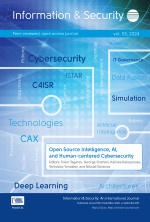Computational Red Teaming: Past, Present and Future
Source:
Computational Intelligence Magazine,Abstract:
The combination of Computational Intelligence (CI) techniques "with Multi-Agent Systems (MAS) offers a great deal of opportunities for practitioners and Artificial Intelligence (AI) researchers alike. CI techniques provide the means to search massive spaces quickly; find possible, better or optimum solutions in these spaces; construct algorithms, functions and strategies to control an autonomous entity; find patterns and relationships "within data, information, knowledge or experience; assess risk and identify strategies for risk treatment; and connect the dots to synthesize an overall situational awareness picture that decision makers can utilize. MAS provide the structured, modular, distributed and efficient software environment to simulate systems; the architecture to represent systems and entities naturally; the environment to allow entities to observe, communicate "with, negotiate "with, orient "with respect to, and act upon other entities; the modular representation that allows entities to store and manipulate observations, forming beliefs, desires, goals, plans, and intentions; and the framework to model behavior. By bringing CI and MAS together, we have a powerful computational environment that has the theoretical potential to do many things that one can expect "when attempting to structure, understand, and solve a problem. In this article, we follow two objectives. First, we "will present Computational Red Teaming (CRT) as the state-of-the-art architecture representing the integration of CI techniques and MAS for understanding competition. Second, we "will demonstrate how this integration of MAS and CI benefits practitioners in almost all major application domains by drawing examples from defense, business and engineering. We "will present the evolution of CRT by categorizing the different levels of integrating CI and MAS, and highlighting open research questions pertaining to CRT.
